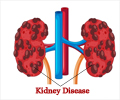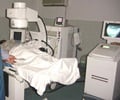Researchers have identified a set of biomarkers of kidney damage - a hallmark of the disorder — and demonstrated that antioxidant therapy protected kidney function in the mice.

The discovery, reported in the July 29, 2013, advance online issue of the Proceedings of the National Academy of Sciences, paves the way for use of antioxidant therapy in a clinical trial for patients with MMA. It also illustrates the mechanisms by which dysfunction of mitochondria—the power generators of the cell—affects kidney disease. Mitochondrial dysfunction is a factor not only in rare disorders, such as MMA, but also in a wide variety of common conditions, such as obesity, diabetes and cancer.
MMA affects as many as one in 67,000 children born in the United States. It can have several different causes, all involving loss of function of a metabolic pathway that moderates levels of an organic compound called methylmalonic acid. Affected children are unable to properly metabolize certain amino acids consumed in their diet, which damages a number of organs, most notably the kidneys.
"Metabolic disorders like MMA are extremely difficult to manage because they perturb the delicate balance of chemicals that our bodies need to sustain health," said Daniel Kastner, M.D., Ph.D., NHGRI scientific director. "Given that every newborn in the United States is screened for a number of inherited metabolic disorders, including MMA, there is a critical need for better understanding of the disease mechanisms and therapies to treat them."
MMA is the most common organic acid disorder and invariably impairs kidney function, which can lead to kidney failure. The most common therapy is a restrictive diet, but doctors must resort to dialysis or kidney transplantation when the disease progresses. MMA patients also suffer from severe metabolic instability, failure to thrive, intellectual and physical disabilities, pancreatitis, anemia, seizures, vision loss and strokes.
"There are no definitive treatments for the management of patients with MMA," said Charles Venditti, M.D., Ph.D., senior author and investigator in the Organic Acid Research Section of NHGRI's Genetics and Molecular Biology Branch. "This study is the culmination of collaboration with the patient community. It uses mouse modelling, coupled with innovations in genomics and biochemical analyses, to derive new insights into the causes of renal injury in MMA. Our studies have improved our understanding of the basic biology underlying MMA, created a novel animal model for testing interventions and, now, led us to the promise of a new therapy."
Advertisement
By measuring gene expression in the transgenic mice using DNA microarrays, researchers discovered 50 biomarkers of gene expression that each indicated declining kidney function. DNA microarrays are silicon chips with many spots to which a given molecule may bind. In this case, the DNA microarrays were used to precisely generate, with the aid of a computer program, a profile of gene expression in a kidney cell.
Advertisement
"The detection of biomarkers through microarray technology is immensely helpful in pointing to downstream pathways affected by the defective MUT activity," said Irini Manoli, M.D., Ph.D., lead author and a physician scientist and staff clinician in NHGRI's Genetics and Molecular Biology Branch. "The biomarkers provide new plasma or serum tests to follow disease progression in our patients."
Having discovered these important biomarkers of kidney function, the authors turned to kidney physiology experts on their team to explore the structural changes that occur in MMA disease. They analyzed the rate at which the kidneys filter waste from the blood. Co-author and renal physiology expert Jurgen Schnermann, M.D., and members of his laboratory at the National Institute of Diabetes and Digestive and Kidney Diseases (NIDDK), also part of NIH, demonstrated the early and significant decrease in this rate in MMA mice.
With further studies, the researchers identified increased production of free radicals in tissues from the mice, as well as in the MMA patients. Detection of free radicals indicates chemical instability in cells, which the researchers sought to remedy with antioxidant therapy. After treating the mice with two forms of dietary antioxidants, the researchers observed that the biomarkers of kidney damage diminished and the faltering kidney filtration rate tapered off. The findings demonstrated that readily available antioxidants can significantly affect the rate of decline of kidney function in transgenic mice, which replicate the kidney disease of MMA.
"The next step will be to translate these findings to the clinic," Dr. Venditti said. "With a progressive disorder like MMA, we are hopeful that we have achieved a laboratory success that our patients will benefit from in the near future."
Source-Eurekalert















